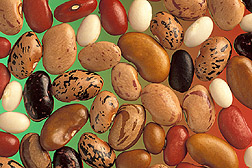| 
Beans. Click the image for additional
information about it.
|
New Pinto
Bean Offers High Yields, Disease Resistance
By Jim Core
October 21, 2003 Dry beans come in many colors and
sizes, but the most popular--based on its 40 percent share of the U.S.
market--is the pinto. And the future looks promising for pinto bean breeders,
partly because of a new, high-yielding pinto line that has unique resistance to
soil pathogenic fungi.
The new line, TARS-PT03-1, has been released by the
Agricultural Research Service and the
University of Tennessee Agricultural
Experiment Station.
The new line offers a new source of resistance to soil-borne fungi that
cause root rot, including Fusarium solani and combinations of F.
solani, Rhizoctonia solani and Pythium species. It also
offers moderate resistance to common bacterial blight (CBB), according to Rusty
Smith, who developed the line. He's a research geneticist at the ARS
Crop Genetics and
Production Research Unit in Stoneville, Miss.
Pinto, dark red kidney, navy, white, great northern, pink, small red and
black beans are all market classes of Phaseolus vulgaris. The new
release was derived from TARS VCI-4B (a small-seeded pinto line derived from
P. vulgaris and P. coccineus), Montcalm (a dark red kidney
cultivar) and MUS PM-31 (a red-mottled tropical germplasm line).
Pinto beans are an excellent source of protein and fiber. Although
TARS-PT03-1 is small-seeded, it should help breeders develop new cultivars with
disease resistance and greater yield potential, according to Smith. It
performed well in trials in temperate regions of the United States, where it
showed good adaptability.
Smith developed the line while based at the ARS Tropical Agricultural
Research Station (TARS)
in Mayaguez, Puerto Rico, with colleagues Soon J. Park of Agriculture Canada,
Phillip N. Miklas of the ARS Vegetable and Forage Crop Research
Unit in Prosser, Wash., and Craig H. Canaday at the University of
Tennessee's West Tennessee
Experiment Station in Jackson.
A limited amount of seed is available to researchers and breeders from
Ricardo Goenaga, TARS research leader, who can be reached via e-mail at:
mayrg@ars-grin.gov
ARS is the U.S. Department of
Agriculture's chief scientific research agency.
|